Lacustrine Slope-Related Soft-Sediment Deformation Structures in the Cretaceous Gyeokpori Formation, Buan Area, SW Korea, and Volcanism-Induced Seismic Shocks as Their Possible Trigger
Abstract
:1. Introduction
2. General Geology
3. Methods
4. Results
4.1. SSDS in the Gyeokpori Formation
4.1.1. Sediment Lenses Embedded in Poorly Sorted Conglomerate
4.1.2. Slump Fold Types
4.2. Dating Results
4.2.1. Seokpo Tuff
4.2.2. Yujeongje Tuff
5. Discussion
5.1. Deformation Mechanisms of the Slope-Related SSDS
5.1.1. Sediment Lenses Embedded in the Poorly Sorted Conglomerate
5.1.2. Slump Fold Types
5.2. Probable Trigger of the Deformations
6. Conclusions
- Envelope structures occur in the proximal to middle parts of the slope, whereas the middle to distal parts are characterized by slump folding;
- The envelope structures were caused by the density contrast between muddy sediments and the overlying gravelly sediments, in combination with a shear stress parallel to the slope;
- Volcanic activity took place during sedimentation of the Gyeokpori Formation (88–86 Ma), and volcanism-induced earthquakes significantly contributed to the development of slump folds;
- The structures of slump folds differ depending on their sand content. Mud sediments promote uniform deformation by acting as cohesive ductile material. The present study allows distinguishing three types of fold structures based on the ratio between sand and finer material (silt and clay).
Supplementary Materials
Author Contributions
Funding
Data Availability Statement
Acknowledgments
Conflicts of Interest
References
- Allen, J.R.L. Sedimentary Structures: Their Character and Physical Basis, Volume II; Elsevier: Amsterdam, The Netherland, 1982. [Google Scholar]
- Alfaro, P.; Moretti, M.; Soria, J.M. Soft-sediment deformation structures induced by earthquakes (seismites) in Pliocene lacustrine deposits (Guadix-Baza Basin, central Betic Cordillera). Eclogae Geol. Helv. 1997, 90, 531–540. [Google Scholar]
- Owen, G.; Moretti, M.; Alfaro, P. Recognising triggers for soft-sediment deformation: Current understanding and future directions. Sediment. Geol. 2011, 235, 133–140. [Google Scholar] [CrossRef]
- Owen, G.; Moretti, M. Identifying triggers for liquefaction-induced soft-sediment deformation in sands. Sediment. Geol. 2011, 235, 141–147. [Google Scholar] [CrossRef]
- Sims, J.D. Earthquake-induced structures in sediments of Van Norman Lake, San Fernando, California. Science 1973, 182, 161–163. [Google Scholar] [CrossRef]
- Sims, J.D. Determining earthquake recurrence intervals from deformational structures in young lacustrine sediments. Tectonophysics 1975, 29, 141–152. [Google Scholar] [CrossRef]
- Hempton, M.R.; Dewey, J.F. Earthquake-induced deformational structures in young lacustrine sediments, East Anatolian Fault, southeast Turkey. Tectonophysics 1983, 98, 7–14. [Google Scholar] [CrossRef]
- Rodríguez-Pascua, M.A.; Calvo, J.P.; de Vicente, G.; Gomez Gras, D. Seismites in lacustrine sediments of the Prebetic Zone, SE Spain, and their use as indicators of earthquake magnitudes during the Late Miocene. Sediment. Geol. 2000, 135, 117–135. [Google Scholar] [CrossRef] [Green Version]
- Moretti, M.; Sabato, L. Recognition of trigger mechanisms for soft-sediment deformation in the Pleistocene lacustrine deposits of the Sant’Arcangelo Basin (southern Italy): Seismic shock vs. overloading. Sediment. Geol. 2007, 196, 31–45. [Google Scholar] [CrossRef]
- Taşgın, C.K.; Türkmen, I. Analysis of soft-sediment deformation structures in Neogene fluvio-lacustrine deposits of Çaybağı Formation. Eastern Turkey. Sediment. Geol. 2009, 218, 16–30. [Google Scholar] [CrossRef]
- Gibert, L.; Alfaro, P.; García-Tortosa, F.J.; Scott, G. Superposed deformed beds produced by single earthquakes (Tecopa Basin, California): Insights into paleoseismology. Sediment. Geol. 2011, 235, 148–159. [Google Scholar] [CrossRef]
- Taşgın, C.K.; Orhan, H.; Türkmen, I.; Aksoy, E. Soft-sediment deformation structures in the late Miocene Şelmo Formation around Adıyaman area, Southeastern Turkey. Sediment. Geol. 2011, 235, 277–291. [Google Scholar] [CrossRef]
- Gibert, L.; Sanz de Galdeano, C.; Alfaro, P.; Scott, G.; Lopez Garrido, A.C. Seismic induced slump in Early Pleistocene deltaic deposits of the Baza Basin (SE Spain). Sediment. Geol. 2005, 179, 279–294. [Google Scholar] [CrossRef]
- Tanner, L.H.; Lucas, S.G. The Moenave Formation: Sedimentologic and stratigraphic context of the Triassic–Jurassic boundary in the Four Corners area, southwestern USA. Palaeogeogr. Palaeoclimatol. Palaeoecol. 2007, 244, 111–125. [Google Scholar] [CrossRef]
- Gladkov, A.S.; Lobova, E.U.; Deev, E.V.; Korzhenkov, A.M.; Mazeika, J.V.; Abdieva, S.V.; Rogozhin, E.A.; Rodkin, M.V.; Fortuna, A.B.; Charimov, T.A. Earthquake-induced soft-sediment deformation structures in Late Pleistocene lacustrine deposits of Issyk-Kul lake (Kyrgystan). Sediment. Geol. 2016, 344, 112–122. [Google Scholar] [CrossRef]
- Jiang, J.; Zhong, N.; Li, Y.; Xu, H.; Yang, H.; Peng, X. Soft sediment deformation structures in the Lixian lacustrine sediments, eastern Tibetan Plateau and implications for postglacial seismic activity. Sediment. Geol. 2016, 344, 123–134. [Google Scholar] [CrossRef]
- Ko, K.; Kim, S.W.; Lee, H.-J.; Hwang, I.G.; Kim, B.C.; Kee, W.-S.; Kim, Y.-S.; Gihm, Y.S. Soft sediment deformation structures in a lacustrine sedimentary succession induced by volcano-tectonic activities: An example from the Cretaceous Beolgeumri Formation, Wido Volcanics, Korea. Sediment. Geol. 2017, 358, 197–209. [Google Scholar] [CrossRef]
- Chough, S.K.; Sohn, Y.K. Tectonic and sedimentary evolution of a Cretaceous continental arc–backarc system in the Korean peninsula: New view. Earth-Sci. Rev. 2010, 101, 225–249. [Google Scholar] [CrossRef]
- Kwon, C.W.; Ko, K.; Gihm, Y.; Koh, H.; Kim, H. Late Cretaceous volcanic arc system in Southwest Korea: Distribution, lithology, age, and tectonic implication. Cretac. Res. 2017, 75, 125–140. [Google Scholar] [CrossRef]
- Koh, H.J.; Kwon, C.W.; Park, S.I.; Park, J.; Kee, W.S. Geological Report of the Julpo and Wido-Hawangdeungdo Sheets (1:50,000); Korea Institute of Geoscience and Mineral Resources: Daejeon, Korea, 2013; 81p, (In Korean, with English abstract). [Google Scholar]
- Byun, U.H.; Van Loon, A.J.; Kwon, Y.K.; Ko, K. A new type of slumping-induced soft-sediment deformation structure: The envelope structure. Geologos 2019, 25, 111–124. [Google Scholar] [CrossRef] [Green Version]
- Byun, U.H.; Van Loon, A.J.; Kwon, Y.K.; Ko, K. Intrastratal flow in the Cretaceous Gyeokpori Formation (SW South Korea). Geol. Q. 2020, 64, 611–825. [Google Scholar] [CrossRef]
- Kim, S.B.; Chough, S.K.; Chun, S.S. Bouldery deposits in the lowermost part of the Cretaceous Kyokpori Formation, SW Korea: Cohesionless debris flows and debris falls on a steep-gradient delta slope. Sediment. Geol. 1995, 98, 97–119. [Google Scholar] [CrossRef]
- Kim, S.B.; Chough, S.K.; Chun, S.S. Tectonic controls on spatio-temporal development of depositional systems and generation of fining-upward basin fills in a strike-slip setting: Kyokpori Formation (Cretaceous), south-west Korea. Sedimentology 2003, 50, 639–665. [Google Scholar] [CrossRef]
- Lowe, D.R. Sediment gravity flows: II. Depositional models with special reference to the deposits of high-density turbidity currents. J. Sediment. Petrol. 1982, 52, 279–297. [Google Scholar]
- Nemec, W.; Steel, R.J. Alluvial and coastal conglomerates: Their significant features and some comments on gravelly mass-flow deposits. [In:] Koster, E.H. & Steel, R.J. (Eds.): Sedimentology of Gravels and Conglomerates. Mem. Can. Soc. Pet. Geol. 1984, 10, 1–31. [Google Scholar]
- Mulder, T.; Alexander, J. The physical character of subaqueous sedimentary density currents and their deposits. Sedimentology. 2001, 48, 269–299. [Google Scholar] [CrossRef]
- Bouma, A.H. Sedimentology of some Flysch Deposits: A Graphic Approach to Facies Interpretation; Elsevier: Amsterdam, The Netherlands, 1962; 168p. [Google Scholar]
- Williams, I.S. U-Th-Pb geochronology by ion microprobe. In Applications of Microanalytical Techniques to Understanding Mineralizing Processes; McKibben, M.A., Shanks, W.C., III, Ridley, W.L., Eds.; Society of Economic Geologists: Socorro, NJ, USA, 1998; Volume 7, pp. 1–35. [Google Scholar]
- Claoué-Long, J.C.; Compston, W.; Roberts, J.; Fanning, C.M. Two Carboniferous ages: A comparison of SHRIMP zircon dating with conventional zircon ages and 40Ar/39Ar analysis. In Geochronology Time Scales and Global Stratigraphic Correlation; Berggren, W.A., Kent, D.B., Auberey, M.P., Hardenbol, J., Eds.; S.E.P.M. (Soc. Sediment. Geol.) Spec. Publ: Broken Arrow, OK, USA, 1995; Volume 54, pp. 3–21. [Google Scholar]
- Paces, J.B.; Miller, J.J.D. Precise U-Pb ages of Duluth complex and related mafic intrusions, northeastern Minnesota: Geochronological insights to physical, petrogenic, paleomagnetic, and tectonomagmatic processes associated with the 1.1 Ga midcontinent rift system. J. Geophys. Res. Solid Earth 1993, 98, 13997–14013. [Google Scholar] [CrossRef]
- Stacey, J.S.; Kramers, J.D. Approximation of terrestrial lead isotope evolution by a two-stage model. Earth Planet. Sci. Lett. 1975, 26, 207–221. [Google Scholar] [CrossRef]
- Ludwig, K.R. User’s Manual for Isoplot 3.6: A Geochronological Toolkit for Microsoft Excel; Berkeley Geochronology Center Special Publication: Berkeley, CA, USA, 2008. [Google Scholar]
- Ludwig, K.R. User’s Manual for SQUID 2; Berkeley Geochronology Center Special Publication: Berkeley, CA, USA, 2009. [Google Scholar]
- Mills, P.C. Genesis and diagnostic value of soft-sediment deformation structures—A review. Sediment. Geol. 1983, 35, 83–104. [Google Scholar] [CrossRef]
- Owen, G. Experimental soft-sediment deformation: Structures formed by the liquefaction of unconsolidated sands and some ancient examples. Sedimentology 1996, 43, 279–293. [Google Scholar] [CrossRef]
- Owen, G. Deformation processes in unconsolidated sands. In Deformation of Sediments and Sedimentary Rocks; Jones, M.E., Preston, R.M.F., Eds.; Geological Society Special Publication 29; Blackwell Scientific Publications: Oxford, UK, 1987; pp. 11–24. [Google Scholar]
- Molina, J.M.; Alfaro, P.; Moretti, M.; Soria, J.M. Soft-sediment deformation structures induced by cyclic stress of storm waves in tempestites (Miocene, Guadalquivir Basin, Spain). Terra Nova 1998, 10, 145–150. [Google Scholar] [CrossRef]
- Seilacher, A. Fault-graded beds interpreted as seismites. Sedimentology 1969, 13, 155–159. [Google Scholar] [CrossRef]
- Obermeier, S.F. Use of liquefaction-induced features for paleoseismic analysis—An overview of how seismic liquefaction features can be distinguished from other features and how their regional distribution and properties of source sediment can be used to infer the location and strength of Holocene paleo-earthquakes. Eng. Geol. 1996, 44, 1–76. [Google Scholar]
- Alsop, G.I.; Marco, S. Soft-sediment deformation within seismogenic slumps of the Dead Sea Basin. J. Struct. Geol. 2011, 33, 433–457. [Google Scholar] [CrossRef]
- Berra, F.; Felletti, F. Syndepositional tectonics recorded by soft-sediment deformation and liquefaction structures (continental Lower Permian sediments, Southern Alps, Northern Italy): Stratigraphic significance. Sediment. Geol. 2011, 235, 249–263. [Google Scholar] [CrossRef]
- Doughty, M.; Eyles, N.; Eyles, C.H.; Wallace, K.; Boyce, J.I. Lake sediments as natural seismographs: Earthquake-related deformations (seismites) in central Canadian lakes. Sediment. Geol. 2014, 313, 45–67. [Google Scholar] [CrossRef]
- Ettensohn, F.R.; Zhang, C.; Gao, L.; Lierman, R.T. Soft-sediment deformation in epicontinental carbonates as evidence of paleoseismicity with evidence for a possible new seismogenic indicator: Accordion folds. Sediment. Geol. 2011, 235, 222–233. [Google Scholar] [CrossRef]
- Taşgın, C.K. Seismically-generated hydroplastic deformation structures in the Late Miocene lacustrine deposits of the Malatya Basin, eastern Turkey. Sediment. Geol. 2011, 235, 264–276. [Google Scholar] [CrossRef]
- Moretti, M.; Ronchi, A. Liquefaction features interpreted as seismites in the Pleistocene fluvio-lacustrine deposits of the Neuquén Basin (Northern Patagonia). Sediment. Geol. 2011, 235, 200–209. [Google Scholar] [CrossRef]
- Neuwerth, R.; Suter, F.; Guzman, C.A.; Gorin, G.E. Soft-sediment deformation in a tectonically active area: The Plio-Pleistocene Zarzal Formation in the Cauca Valley (Western Colombia). Sediment. Geol. 2006, 186, 67–88. [Google Scholar] [CrossRef]
- Odonne, F.; Callot, P.; Debroas, E.-J.; Sempere, T.; Hoareau, G.; Maillard, A. Soft-sediment deformation from submarine sliding: Favourable conditions and triggering mechanisms in examples from the Eocene Sobrarbe delta (Ainsa, Spanish Pyrenees) and the mid-Cretaceous Ayabacas Formation (Andes of Peru). Sediment. Geol. 2011, 235, 234–248. [Google Scholar] [CrossRef]
- Rossetti, D.F.; Bezerra, F.H.R.; Góes, A.M.; Neves, B.B.B. Sediment deformation in Miocene and post-Miocene strata, Northeastern Brazil: Evidence for paleoseismicity in a passive margin. Sediment. Geol. 2011, 235, 172–187. [Google Scholar] [CrossRef]
- Gottsmann, J.; Martí, J. Caldera Volcanism: Analysis, Modelling and Response; Elsevier: Amsterdam, The Netherland, 2011. [Google Scholar]
- Gao, Y.; Jiang, Z.; Best, J.; Zhang, J. Soft-sediment deformation structures as indicators of tectono-volcanic activity during evolution of a lacustrine basin: A case study from the Upper Triassic Ordos Basin, China. Mar. Petrol. Geol. 2020, 115, 104250. [Google Scholar] [CrossRef]
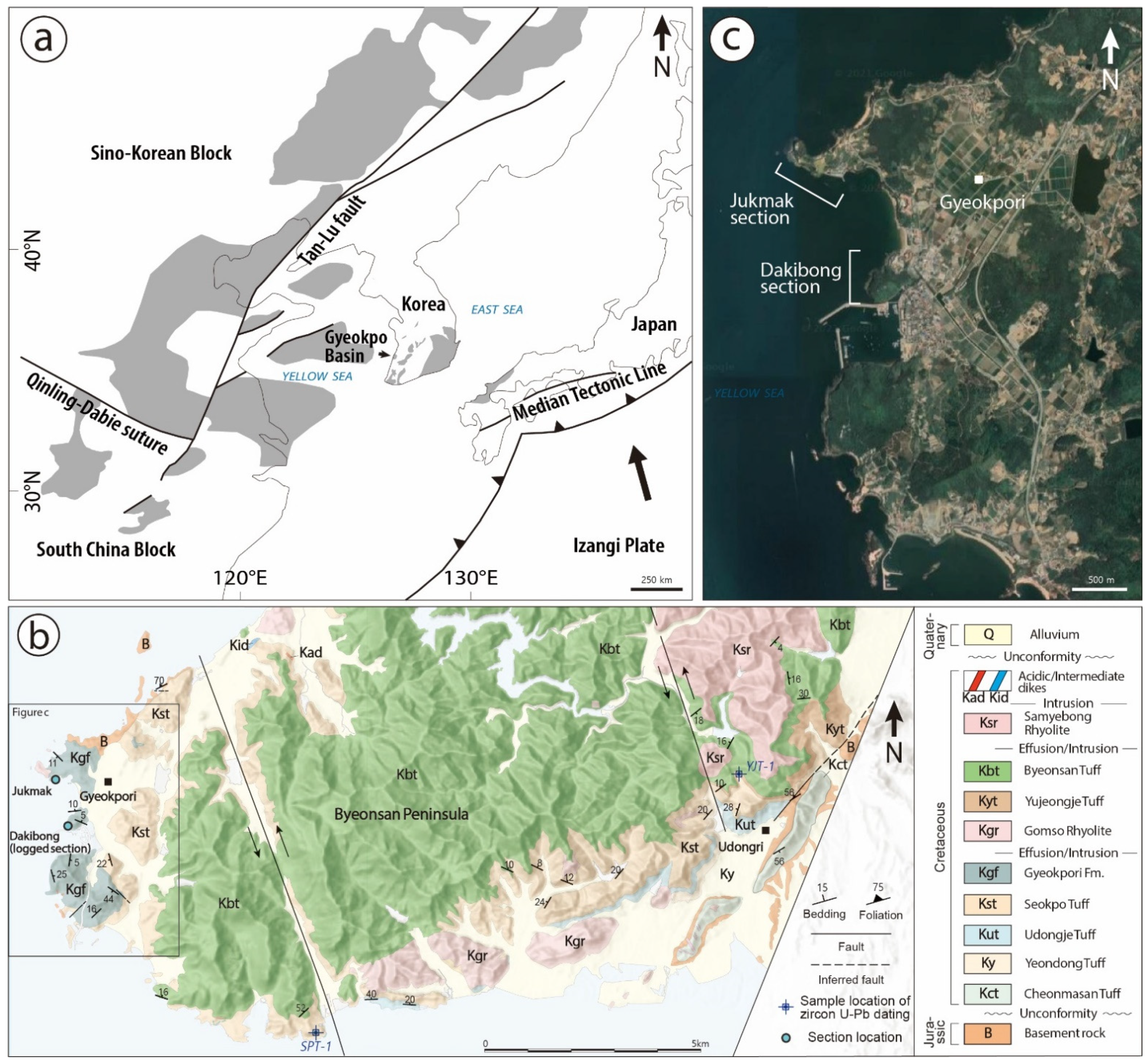
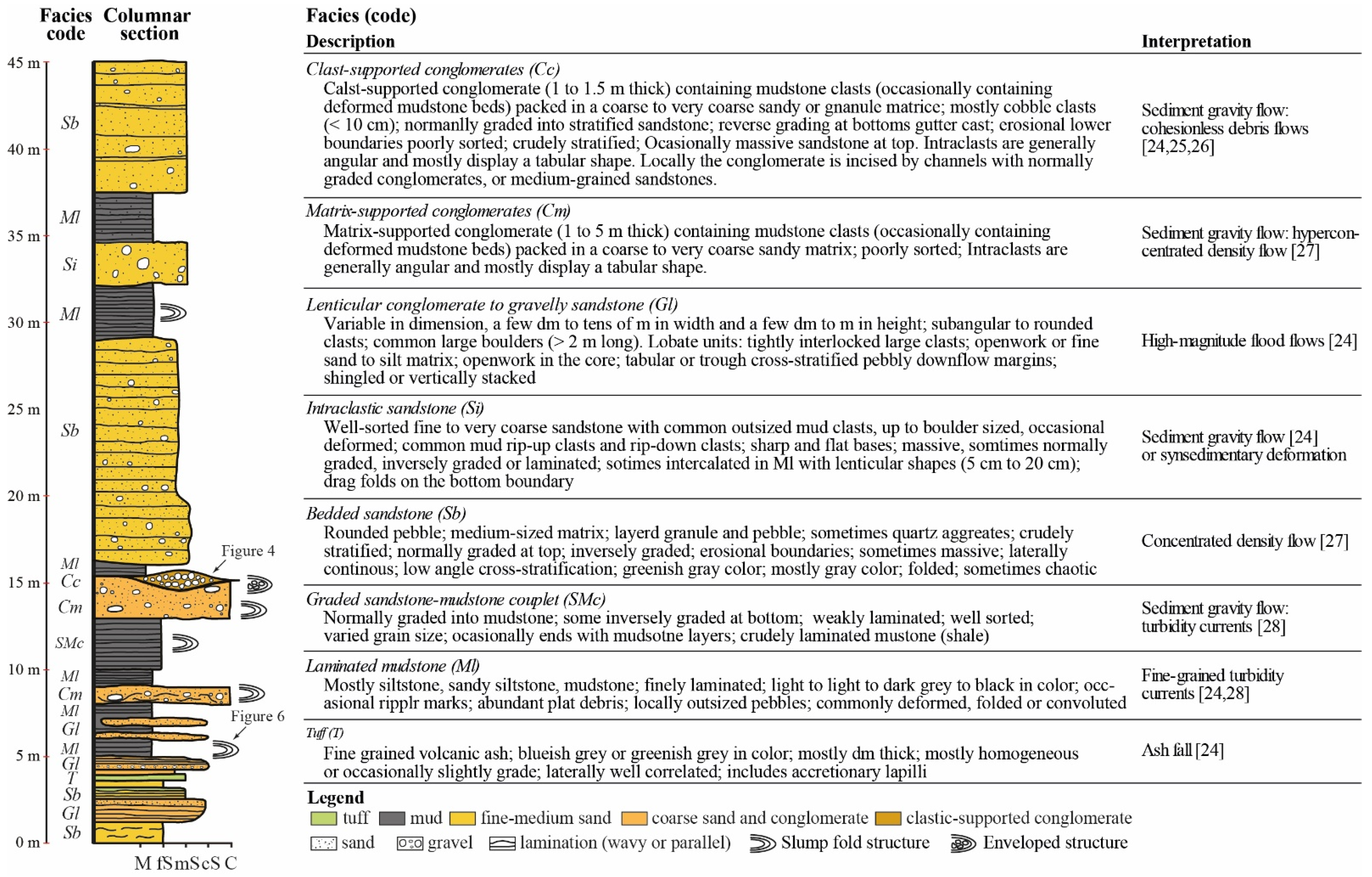
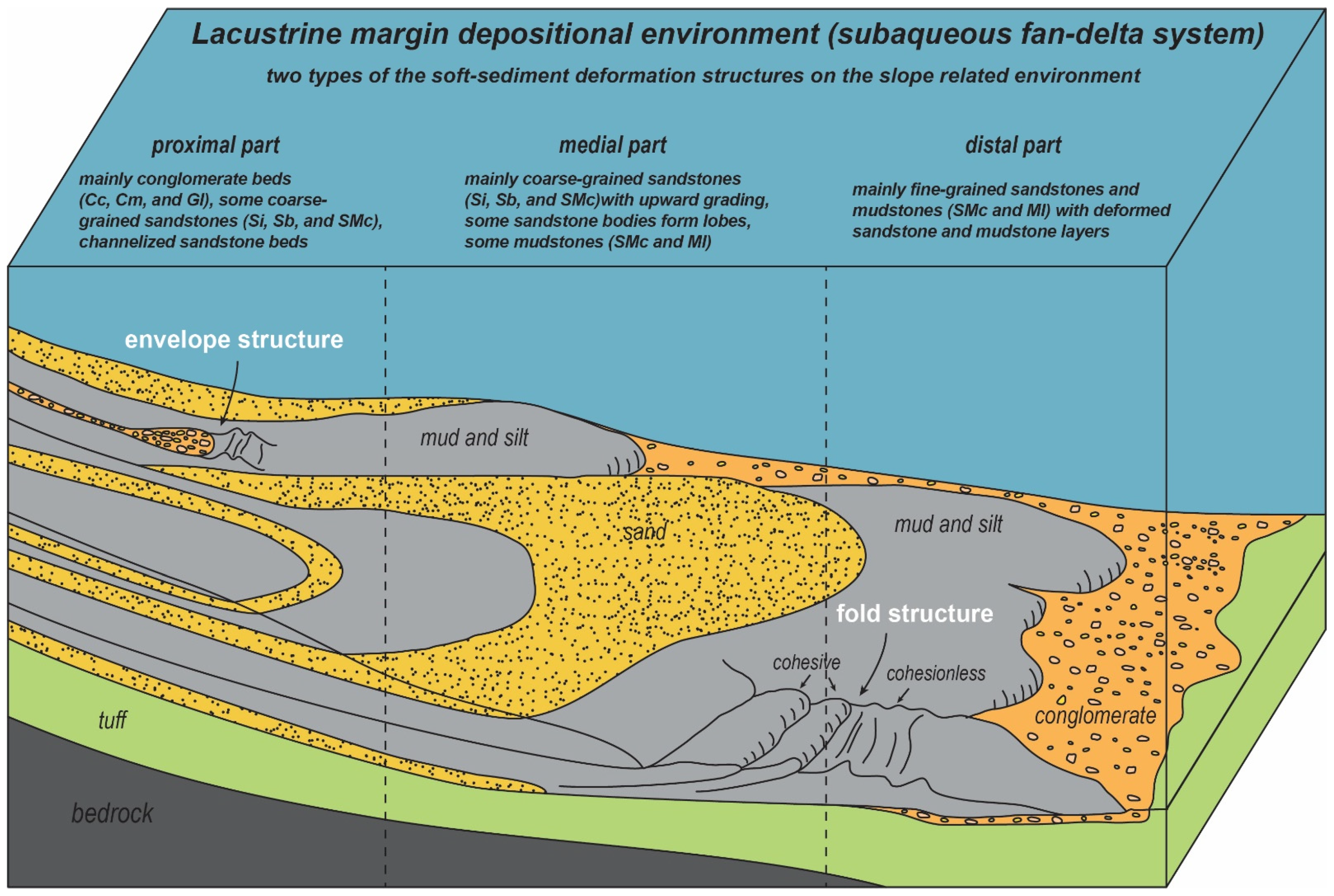
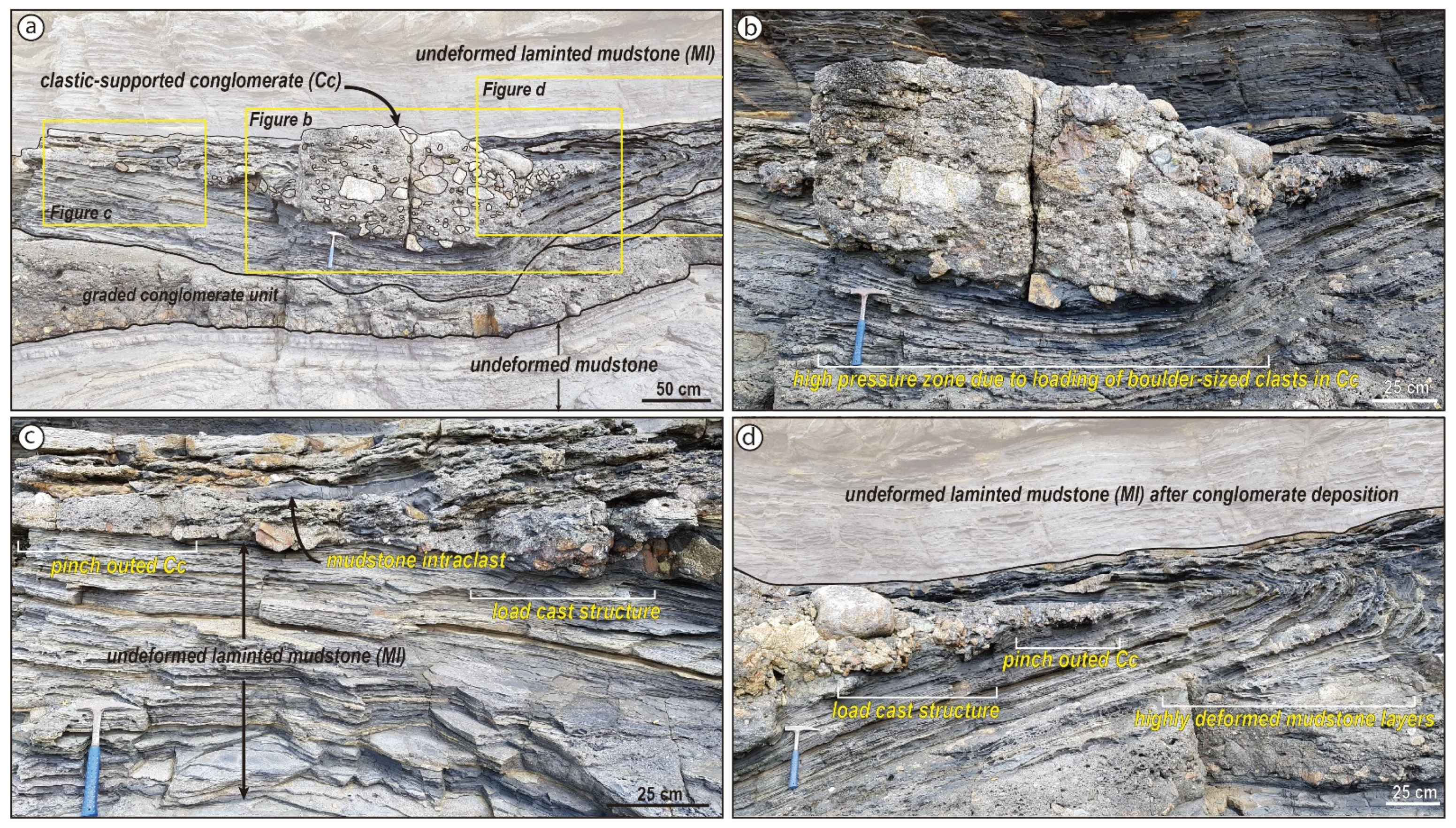
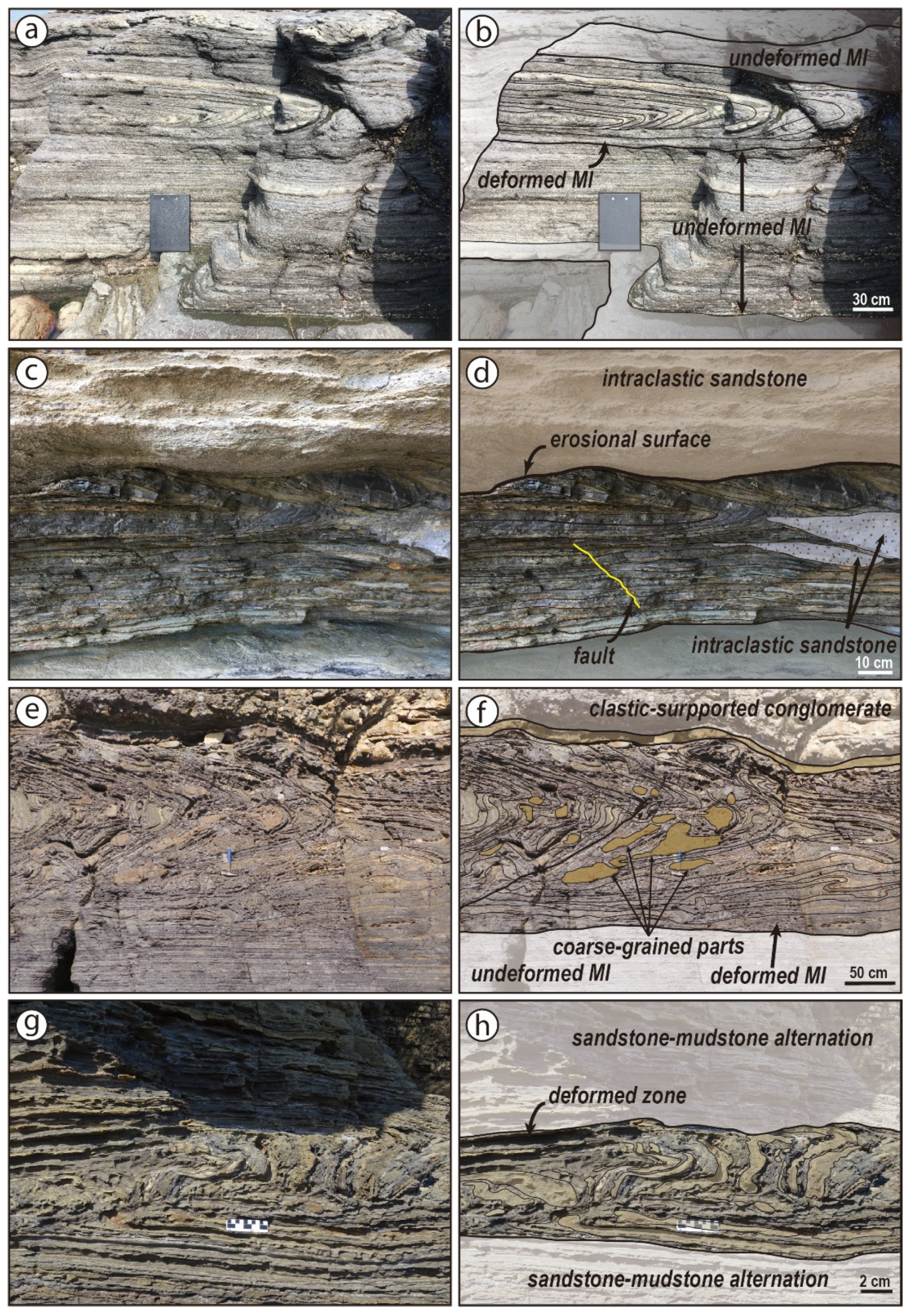

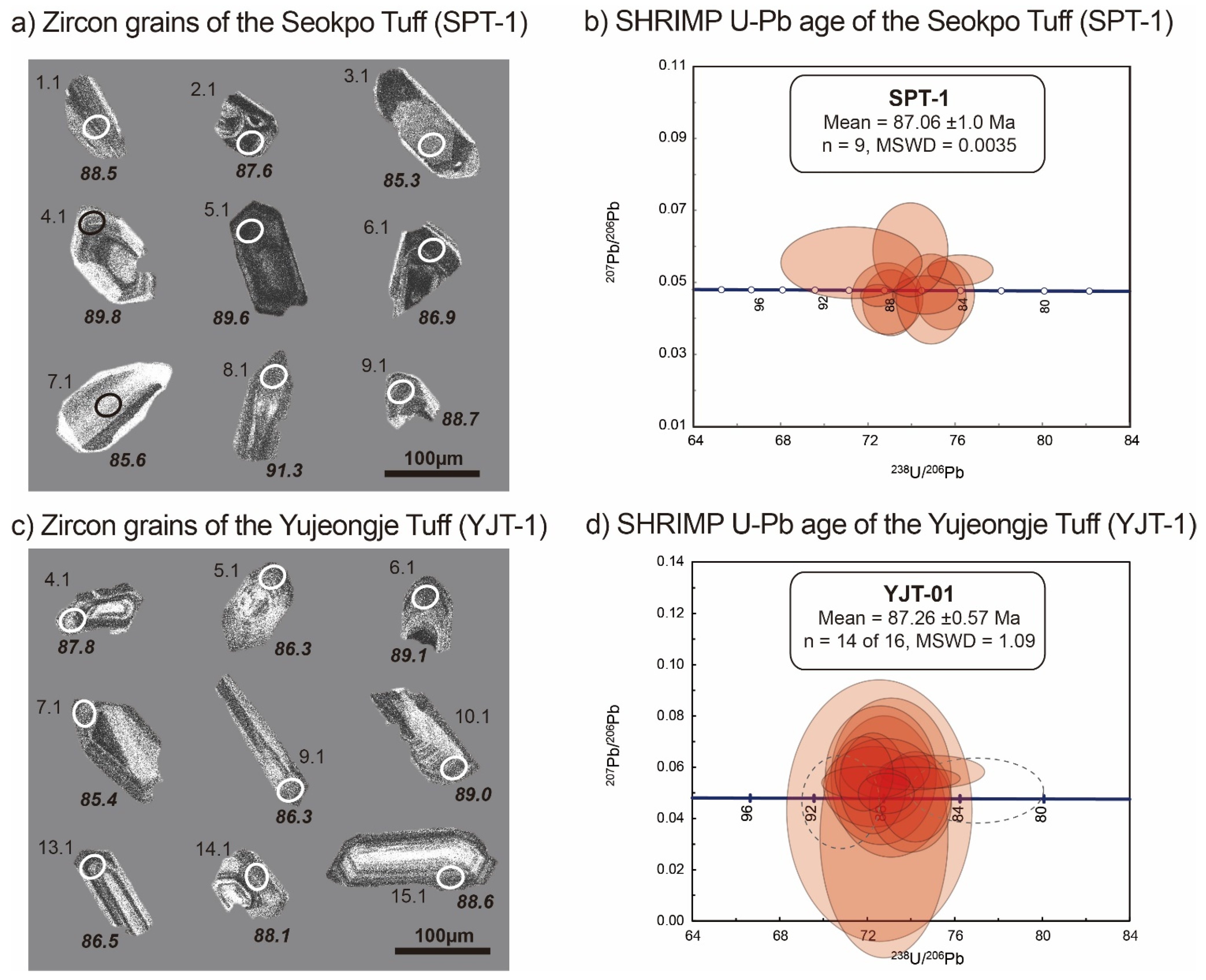
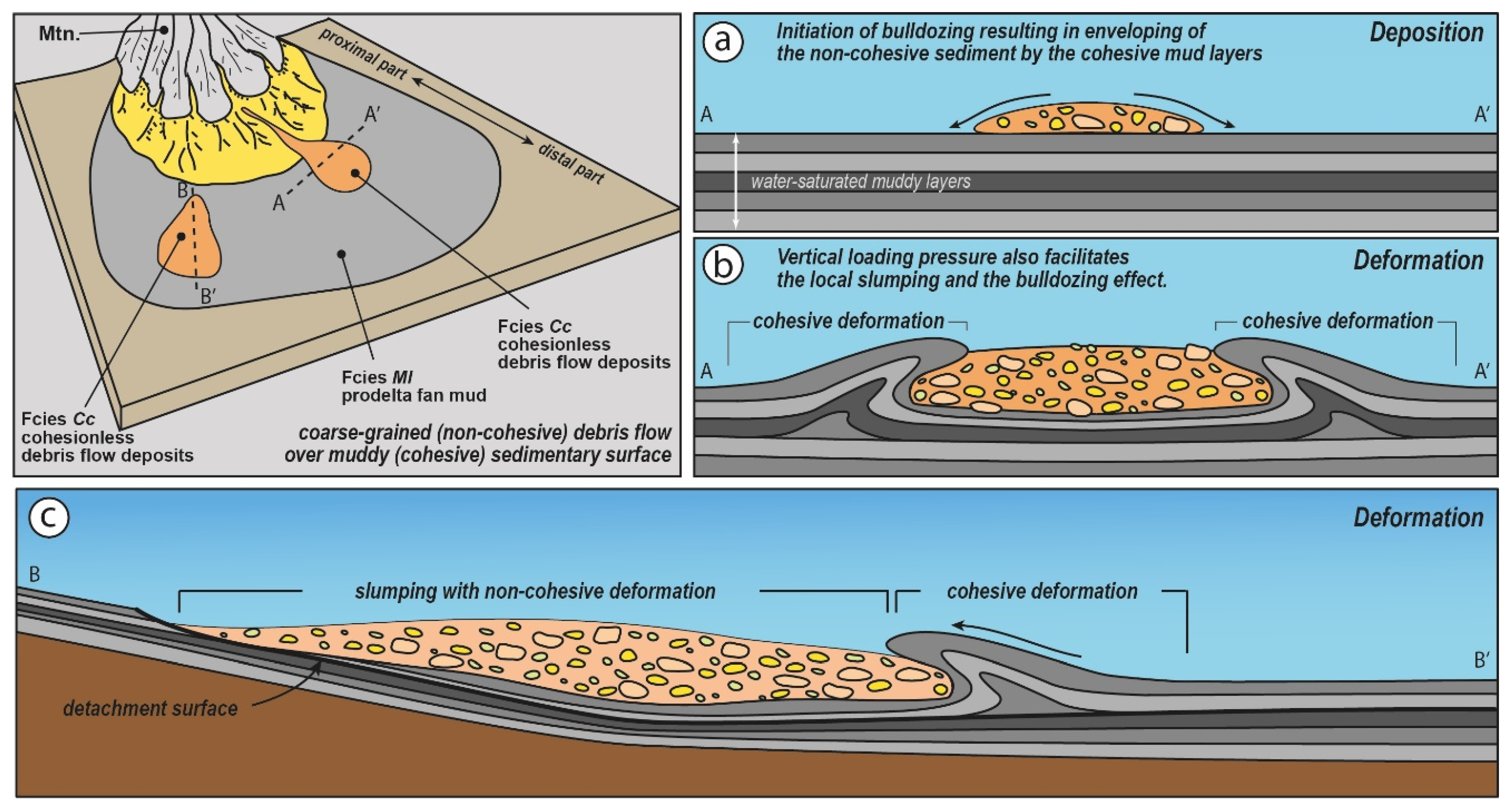
Publisher’s Note: MDPI stays neutral with regard to jurisdictional claims in published maps and institutional affiliations. |
© 2021 by the authors. Licensee MDPI, Basel, Switzerland. This article is an open access article distributed under the terms and conditions of the Creative Commons Attribution (CC BY) license (https://creativecommons.org/licenses/by/4.0/).
Share and Cite
Byun, U.H.; van Loon, A.J.; Ko, K. Lacustrine Slope-Related Soft-Sediment Deformation Structures in the Cretaceous Gyeokpori Formation, Buan Area, SW Korea, and Volcanism-Induced Seismic Shocks as Their Possible Trigger. Minerals 2021, 11, 721. https://doi.org/10.3390/min11070721
Byun UH, van Loon AJ, Ko K. Lacustrine Slope-Related Soft-Sediment Deformation Structures in the Cretaceous Gyeokpori Formation, Buan Area, SW Korea, and Volcanism-Induced Seismic Shocks as Their Possible Trigger. Minerals. 2021; 11(7):721. https://doi.org/10.3390/min11070721
Chicago/Turabian StyleByun, Uk Hwan, A.J. (Tom) van Loon, and Kyoungtae Ko. 2021. "Lacustrine Slope-Related Soft-Sediment Deformation Structures in the Cretaceous Gyeokpori Formation, Buan Area, SW Korea, and Volcanism-Induced Seismic Shocks as Their Possible Trigger" Minerals 11, no. 7: 721. https://doi.org/10.3390/min11070721
APA StyleByun, U. H., van Loon, A. J., & Ko, K. (2021). Lacustrine Slope-Related Soft-Sediment Deformation Structures in the Cretaceous Gyeokpori Formation, Buan Area, SW Korea, and Volcanism-Induced Seismic Shocks as Their Possible Trigger. Minerals, 11(7), 721. https://doi.org/10.3390/min11070721




